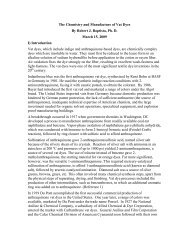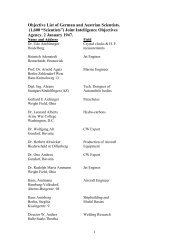International Dyestuff Industry - ColorantsHistory.Org
International Dyestuff Industry - ColorantsHistory.Org
International Dyestuff Industry - ColorantsHistory.Org
Create successful ePaper yourself
Turn your PDF publications into a flip-book with our unique Google optimized e-Paper software.
Aug.<br />
Oehler<br />
(Offenbch)<br />
45-80 60<br />
“ 55 55 55<br />
1866<br />
June Poirrier 125<br />
(violet<br />
de Paris)<br />
July Imbert Hofmann’s<br />
1867 10-50 30-250 35-75<br />
60 Hofmann’s<br />
soluble<br />
Sources: Theodore Chateau, Nouveau Manuel Complet Theorique et Pratique de la<br />
Fabrication et de I Emploi des Couleurs d’Aniline 2 vols. (Paris, 1868), vol 2, pp 450-462.<br />
Moniteur Scientifique, 2 (1 November 1859):403. Le Teinturier Universal, 1861-1863,<br />
inclusive.<br />
Notes to Table 1: The aniline blues listed for the early part of 1861 may have been blue<br />
shades of red Aniline purple == mauve (UK) = harmaline (France), etc. Aniline red =<br />
magenta (UK) = fuchsine (France), etc. Wide price variations in aniline blues (phenylated<br />
reds) and violets (alkylated reds) arose from introduction of improved products, especially<br />
the water soluble varieties. Qualities within a given range were designated by additions of<br />
capital B’s after the name of the dye. Thus, blue BBBB was superior to Blue BBB Aniline<br />
greens were made by the reaction of aldehydes on aniline red, and were especially<br />
important products for Usebe-Cherpin, Muller-Pack and Meister, Lucius & Co. from 1864. In<br />
August 1864, green was quoted at 25 fr per kg, probably of poor quality. By August of the<br />
following year a superior product was fetching 350 . fr per kg Aniline yellow was quoted at<br />
400 fr per kg in June 1864, and 250-300 fr per kg in November 1864. In 1867, La<br />
Fuchsine’s “Durand” yellows, browns, etc. were 15-30 fr per kg. L. Durand was one of the<br />
company’s chemists and later became a partner in Durand & Huguenin. Prices in Germany<br />
in 1860 revealed that aniline purple was the equivalent of about 1,250 fr per kg, and aniline<br />
red about 700 fr per kg.<br />
The rise of the German and Swiss dye industries<br />
German manufacturers of aniline dyes become significant in the early 1860s Swiss<br />
dye-making was assisted by the patent monopoly in France.





